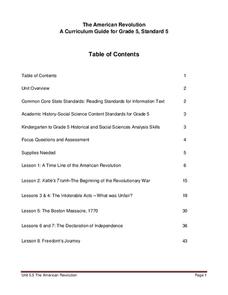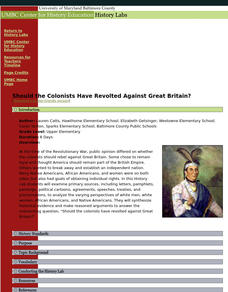Smithsonian Institution
Who's in Camp?
Pupils complete readings, a group activity using cards, and a writing activity to better understand people's lives during the American Revolution. The resource emphasizes people such as the militiamen, women, officers, and children,...
Film Foundation
Mr. Smith Goes to Washington: What Is a Movie?
Watching is not the same as seeing. Transform viewers from passive watchers to active students of film with this 34-page packet, filled with lessons and activities that use Mr. Smith Goes to Washington to examine the technology, the...
Curated OER
Unit 2: Post-Revolution: The Critical Period 1781-1878
The post-Revolutionary Period of 1781-1787, also known as the Critical Period, is the focus of a series of lessons that prompt class members to examine primary source documents that reveal the instability of the period of the...
National Endowment for the Humanities
James Madison: Madison Was There
Madison was there! Scholars go on a journey to discover the person behind the founding father label as they explore James Madison's role in the formation of the United States government. The culmination is a writing assignment and...
Alabama Learning Exchange
J. Alfred Hyperbolizes
Mermaids will sing to your class members as they engage in an activity related to T.S. Eliot's famous dramatic interior monologue. After engaging in a socratic seminar about literary devices in the poem, individuals choose one...
Curated OER
Japanese Tea and Teacups
Upper graders use the potter's wheel to make Japanese style tea cups, which they will use in a Japanese style tea ceremony. They hone their sculpting techniques while exploring Japanese cultural and the history of tea. There are two...
Curated OER
Say Hi to Haibun Fun
What is a haibun? With this interesting lesson plan, writers will experience the Japanese writing form haibun, identify elements important to Japanese writing styles, analyze a haibun, and compose their own. Different from the typical...
California State University
The American Revolution
Invite your class on a ride through the American Revolution. Young historians travel through time as they explore the events that led to the foundation of the United States of America. Over the course of eight lessons, this unit...
Curated OER
Not Everyone Lived in Castles During the Middle Ages
Students complete a variety of online activities surrounding their study of the Middle Ages. They focus on the various levels of the class sytem and then role play a member of a given class.
Curated OER
Building a Documentary Library
Documentary films allow your class to visit new places and gain a deeper understanding of complex issues.
National Endowment for the Humanities
Chronicling America: Uncovering a World at War
As part of a study of World War I, class members read newspaper articles from the time that urge American involvement, non-involvement, or neutrality. Using the provided worksheet, groups analyze the articles noting the central argument...
Curated OER
Holocaust and Resistance
Students complete a unit of lessons that examine the Holocaust from the point of view of those who actively resisted the Nazis. They analyze a timeline, participate in a class debate, explore various websites, and write a letter.
National Constitution Center
Interactive Constitution
Did you know there are seven Articles and 27 Amendments to the US Constitution? Explore each and every one of them, including the Bill of Rights and other rights around the world, in a super neat US Constitution interactive.
Curated OER
I Hear the Locomotives: The Impact of the Transcontinental Railroad
Students examine the effects the Transcontinental Railroad had on the regions through which it passed. They analyze and discuss maps, view and describe online images, and use photos and documents to develop a cause-and-effect ladder.
Curated OER
Life in Old Babylonia: The Importance of Trade
Middle schoolers read maps and artifacts for information indicating the existence of a trade network in Old Babylonia and beyond. They list goods imported to and exported from Babylonia. They indicate trading centers on a map of ancient...
Curated OER
On the Road with Marco Polo: From Hormuz to Venice
Students study the route from Hormuz to Constantinople that was traveled by the Polos. They explain the importance of Constantinople in medieval time and discuss its location, and outer wall structure.
Center for History Education
Should the Colonists Have Revolted Against Great Britain?
Should the Americans have taken the plunge and revolted against Great Britain? Using documents, including the famed Common Sense and a Loyalist response, pupils conduct a lengthy investigation of the question. The interesting resource...
National Endowment for the Humanities
Trekking to Timbuktu: Mansa Musa Takes a Trip - Teacher Version
Eleventh graders identify Mansa Musa and discuss his pilgrimage, explain how he related to leaders in the East, and describe decisions he made about his homeland. They discuss changes brought about in Mali as a result of his pilgrimage.
Curated OER
Trekking to Timbuktu: Restoring the Past
Students investigate the environmental factors that threaten Timbuktu. Students investigate what measures are being taken to restore their mosques, and the condition of their ancient manuscripts. Students discover information about the...
Curated OER
Trekking to Timbuktu: A Center of Trade
Middle schoolers conduct online research regarding the origins of the city of Timbuktu and discover why it became such an important place. Students write about the city's origins until it became a part of Mali.
Curated OER
On the Road with Marco Polo: Marco Polo in China
Young scholars investigate who the Mongols were and where their empire was located. They research Kublai Khan and the region he ruled. They study the major products of 13th Century China.
Curated OER
On the Road with Marco Polo: Sea Voyage to India
Students examine Marco Polo's route from China to Sumatra. They investigate the geography and climate, the religions and architecture of modern Indonesia. They study the use of spices and why they were so important in medieval times.
Curated OER
On the Road with Marco Polo: Homecoming
Students role play as Marco Polo to detail his travels. They include the terrains, foods, religions, people and cultures that were encountered. They write a journal entry as if they were Marco Polo detailing one aspect of his travels.
National Endowment for the Humanities
Lesson 1: On the Road with Marco Polo: A Boy in 13th Century Venice
Learners investigate Marco Polo's life as a young boy in 13th century Venice. They analyze maps, explore various websites, complete a chart and answer discussion questions, and create a travel brochure about visiting 13th century Venice.























